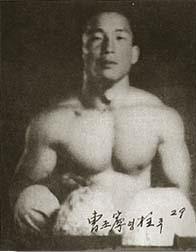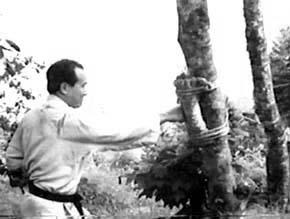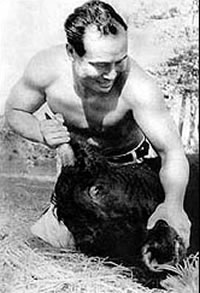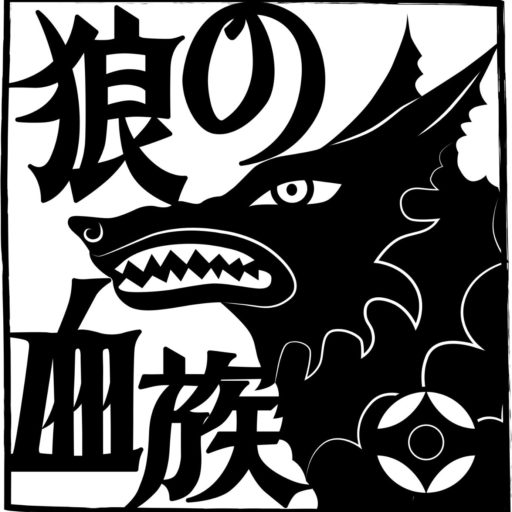
Foundations of Kyokushin
Kyokushinkai is Japanese for “society of the ultimate truth” and was founded in 1964 by Masutatsu Oyama and is rooted in a philosophy of self-improvement, discipline and hard training.
Masutatsu Ōyama, more commonly known as Mas Oyama or Sosai was born born Choi Yeong-eui on 4 June 1923 in what is now South Korea. He lived in a village in Southern Korea before moving to live on his sister’s farm in Manchuria, Southern China at the age of nine where he had his first contact with martial arts studying a form of Chinese boxing from a farmer working on his sister’s farm.
At the age of 15, Sosai followed his brother who enrolled in the Imperial Japanese Army’s Yamanashi Aviation School. Realising his dream of training to become a pilot in the imperial forces he started judo training which was practiced at the military academy, finally obtaining a rank of 4th dan. After the war ended in 1945, Sosai left the aviation school and the next year enrolled Waseda University School of Education to study sports science. In Japan he began training in judo and boxing before eventually beginning karate, namely Shotokan under the guidance of Gigō Funakoshi, the second son of karate master and Shotokan founder Gishin Funakoshi and Goju Ryu with So Nei Chu a senior student of the system’s founder, Chojun Miyagi.
It was his Goju master, So Nei Chu, who advised him to retreat to the mountains and consolidate everything he had learnt. Sosai intended to remain in isolation for three years perfecting all that he had learnt so far, however, after 14 months his sponsor had to withdraw their support and Sosai was forced to return to society. It was at this time that the first All Japan Martial Arts Tournament was conducted after World War II where Sosai entered and easily won the karate section.


Upon reflection and with further guidance from So Nei Chu, Sosai returned to the mountains for a further 18 months armed with renewed vigour. Once again, he battled daily against the elements and building upon his strength and abilities even more by using his natural surroundings as training partners. Sosai redefined the meaning of karate by taking what he felt were the best techniques and concepts from any martial art and gradually fit them into his training; therefore, laying the foundations of Kyokushin.
Without a training partner Sosai spent up to 12 hours per day practicing kihon, kata, sometimes under icy cold waterfalls or in the river, also using trees, logs, rocks as makiwara. Sosai was relentless in his quest; he was testing the boundaries of human strength by pushing himself to limits undreamt of by himself or anyone else, he was taking control of his life and, if he wanted others to follow the same path, he would need to lead by example. It wasn’t all harsh physical challenges Sosai spent the days end often reading, practicing calligraphy, teaching himself to play the flute and meditating.
In 1950, Sosai returned to society to demonstrate his brand of karate and to show that if one seeks to realize their true potential in anything they only need to learn how to push themselves beyond the limits of just trying. It is about this time that Sosai began his famous battles with bulls. He fought 52 bulls in his life killing 3 instantly and taking the horns of 49 others with the shuto or knife hand strike after downing them. It is also around this time he began touring around the world to demonstrate the power of Japanese karate and particularly his brand of karate. Sosai took on all challengers and dispensed with most with a single technique, hence the maxim ichi geki hissatsu (one stike, certain death). Not many of the fights lasted more than 3 minutes and once he started, or got hold of his opponents, rarely more than a few techniques were exchanged due to their immense power.
In 1953, Sosai opened his first dojo, the Oyama Dojo, in Mejiro, Tokyo and was the time that Sosai’s karate strength was at its peak so the training was severe and kumite was or near to jissen (actual combat or real fighting) with a high drop-out rate. However, severe as it was, many stayed and from these students Sosai found his instructors who would help teach and pass on his style of karate.
Many students were members of other styles and Sosai would compare styles and build on his karate taking what he felt were the best techniques and concepts from any martial art and gradually fit them into his training; therefore, laying the foundations of Kyokushin Karate. Kyokushin has always been ever-evolving and is testament to the many great fighters who have dominated in the many All Styles Full Contact Tournaments, Kick-Boxing, K1 and MMA.


It is no secret that gradings in Kyokushin can be very demanding, particularly the yudansha (black belts) gradings. And if gradings and full contact tournaments weren’t enough there are always the challenges of the 50 man fight that some countries offer to students who wish to keep challenging new boundaries or, ultimately, the Hyakunin Kumite (100 man fight), which is done in Japan in front of organisation heads who judge and rule over the procedure and the outcome as it is recorded. Hyakunin Kumite has only been obtained by a few, although many have attempted the feat over the years. Without the experience of attempting such a feat, let alone completing it, one can only imagine the immensely tough and severe training regime required and an attitude that would truly define budō. The few who have completed the 100 man fight have successfully gone on to win the Open World Tournament that is held every 4 years. There are no weight divisions and it’s really a “take on all comers” approach, fought with the International Karate Organizations rules.
The building of the World Headquarters started in 1963 and was officially opened in 1964. It was at this time that Sosai adopted the name Kyokushin meaning the Ultimate Truth. Of course, any style is only as strong as the students who represent it which is why it is the responsibility of all those who have chosen Kyokushin to train hard and forge and indomitable spirit so that the tradition of strength in Kyokushin may continue to be recognised.
Sosai built his Tokyo-based International Karate Organization, Kyokushinkaikan, into one of the world’s foremost martial arts associations, with branches in more than 100 countries boasting over 12 million registered members. In Japan, books were written by and about him, feature-length films splashed his colourful life across the big screen, and comic books recounted his many adventures.
Oyama died at the age of 70 in Tokyo, Japan on April 26, 1994, due to lung cancer.
